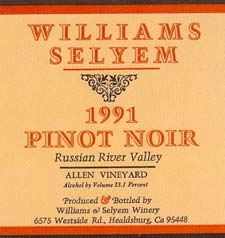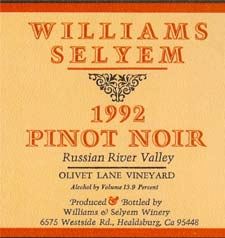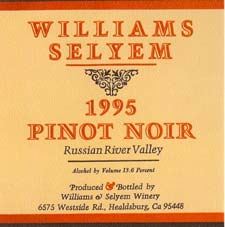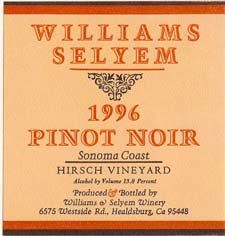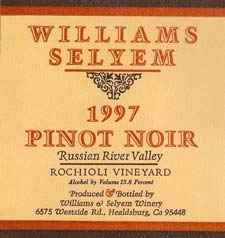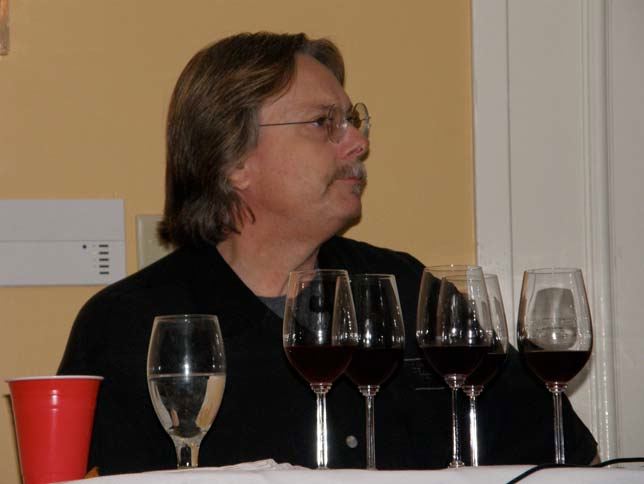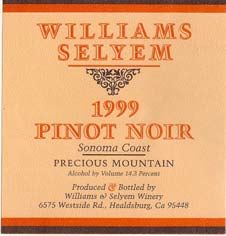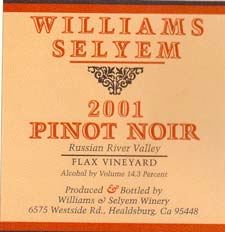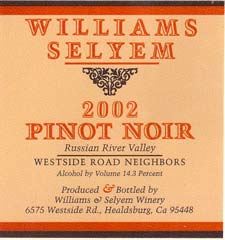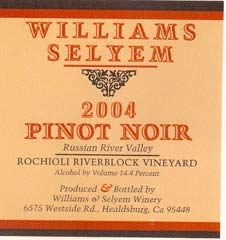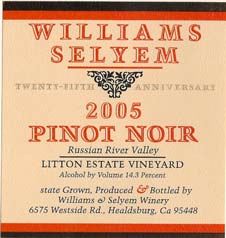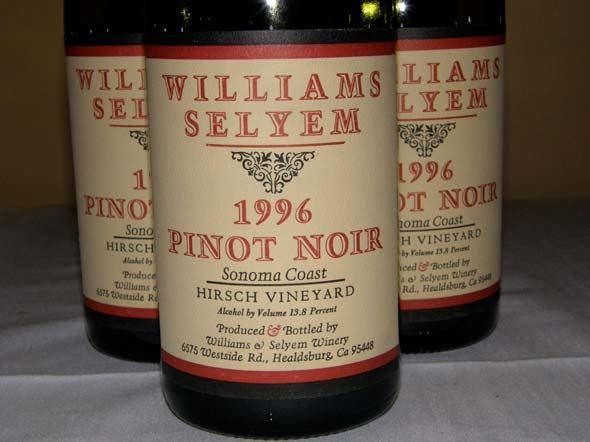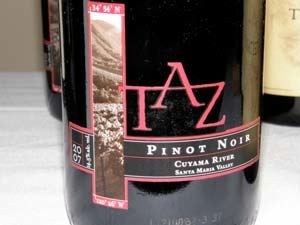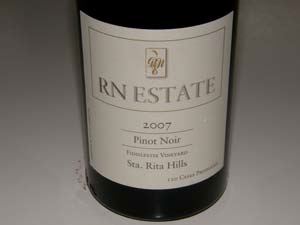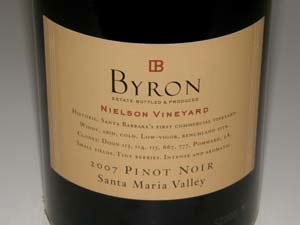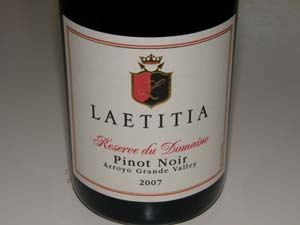On the Pinot Trail: WOPN 2010
The 2010 season of major Pinot Noir events was kicked off in Shell Beach, California on March 5 and 6 with
the Tenth Anniversary of the World of Pinot Noir. My report which follows includes coverage of two major
seminars and reviews of multiple wines tasted at the event.

Current William Selyem winemaker, Bob Cabral, and moderator, Michael Jordan, MS, and owner of WORD
Wines, kicked off the weekend’s festivities with an unprecedented tasting of Williams Selyem Pinot Noirs
released over the period of 1993 to 2005. The tasting was divided into two segments: the “Burt” years (wines
from 1991, 1992, 1995, 1996 and 1997 crafted by co-founder of Williams Selyem, Burt Williams) and the “Bob”
years (wines from 1999, 2001, 2002, 2004 and 2005 made by Bob Cabral who joined Williams Selyem in July
1998). All the wines came from the library cellars of Williams Selyem guaranteeing their provenance. The two
hosts offered many interesting background comments about each wine tasted, accompanied by an extensive
photo presentation of the vineyards involved. The only thing missing were Burt and Ed.
The Williams Selyem Story has been told many times in the PinotFile, most recently in Volume 8, Issue 11
(www.princeofpinot.com/article/851/). When John Dyson acquired the winery in 1997, some vineyard sources
predicated on a handshake agreement were lost (Olivet Lane Vineyard, Rochioli West Block), and new
vineyard sources were acquired (Flax Vineyard, Bucher Vineyard, Weir Vineyard, and Peay Vineyard). Olivet
Lane Vineyard will be picked up again beginning with the 2009 vintage. Dyson had the financial resources to
also acquire land for estate vineyards, something Burt and Ed could never afford. The Drake Estate, consisting
of about 35 acres of Pinot Noir and 2 acres of Chardonnay was planted on a property near Guerneville and the
first crop was harvested in 2001. A second estate vineyard, the Litton Estate, was planted in 2002 on Westside
Road about one mile south of the Allen Ranch where the original Williams Selyem production facility was
located. The Litton Estate is 32 acres of Pinot Noir planted to multiple heritage selections and first harvested in
2005. The inaugural bottling of Williams Selyem Litton Estate Pinot Noir received a 100 point score from Wine
Enthusiast magazine in 2010. The emphasis at Williams Selyem is on heritage selections, not Dijon clones.
The current Williams Selyem customer list has between 35,000 and 40,000 people.
The “Burt” Years
Burt’s wines were known for their stunning aromatics and the wines presented at the seminar confirmed his
reputation. The aromas had taken on secondary characters, or bouquet, and were still stunning examples of
Russian River Valley and Sonoma Coast Pinot Noir. All the wines have aged gracefully and only the 1991
Pinot Noir was on the downside. It is no wonder that Burt Williams has become a winemaker icon.
What were Burt’s secrets? First, he was meticulous in his winemaking and kept extensively detailed notes. He
attempted to employ the same winemaking techniques for each vineyard which included de-stemming the
grape clusters and adding back 20% to 30% whole clusters on the bottom of the fermentation tank, inoculating
a Zinfandel yeast acquired from Jackass Vineyard (which is still in use today), employing intense sorting (the
initial sorting table was a 4’ x 8’ piece of plywood), avoiding pumping using gravity only or assisted gravity with
gas, initiation of hand punch downs with the onset of fermentation, and 5 day cold soaks during which time ice
and sulfur dioxide was added to prevent fermentation. Free run juice was sent to barrel, the residual must and
juice was bucketed into the press, gently pressed, and added to the top of the barrel. Varying amounts of oak
were used depending on the vintage and the wine.
All the Williams Selyem wines over the past 30 years have been sourced from vineyards in the Russian River
Valley and Sonoma Coast. Jordan pointed out that the Russian River Valley has more soil types than all of
France with 400 different soil types in 150 square miles. The earliest documented vineyard in the Russian
River Valley was planted in 1839 by Yegor Tschernick. By 1891, there were 300 growers and 7,000 acres of
vines. Prohibition and phylloxera killed the wine industry and the region became known for apples, plums and
other fruit. Today, there are more than 65 wineries and 13,000 acres planted. The Russian River Valley can be
divided into three regions: the Middle Reach which is the most northern area with volcanic ash soils, Green Valley with Goldridge soils, and the Laguna Ridge/Santa Rosa Plain with Goldridge soils along the Laguna
Ridge and clay soils on the Plain. The distinguishing climatic feature of the Russian River Valley is the fog
which is often termed “heaven’s refrigeration.” It keeps the grapes cool and allows acids to develop. The
plentiful daytime sun (it can reach 100 degrees in the summer) creates tannins.
The Sonoma Coast is the largest AVA in Sonoma County at 500,000 acres, but it is the least planted area. It
has more than twice the annual rainfall of the Russian River Valley, but it is warm enough to ripen wine grapes
because the vineyards are located on ridges above the fog line. Because the vineyards are within a few miles
of the Pacific Ocean, farming here is literally on the edge and quite risky. There are years, such as in 2005,
when some crops were completely damaged, but in the best years, the quality is extraordinary.
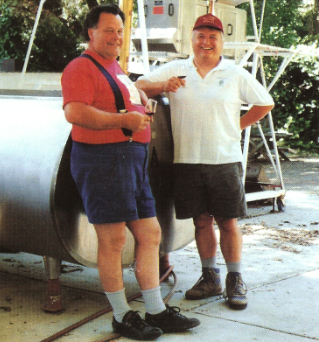
Allen Vineyard Howard and Ann Allen began growing grapes in the Russian River Valley in 1970 on a former
prune orchard and pasture along Westside Road. Howard worked with neighbor, Joe Rochioli, and soon was
selling grapes to the Allen’s other neighbor, Williams Selyem. The first Williams Selyem Allen Vineyard Pinot
Noir was produced in 1980. The Allen Vineyard consists of 14.8 acres of Pinot Noir and 15.63 acres of
Chardonnay. The Pinot Noir is an old Pommard selection that is also planted in the West Block and East Block
of the Rochioli Vineyard. Some Dijon 115 was added in 2004.
1991 Williams Selyem Allen Vineyard Russian River Valley Pinot Noir
13.1% alc.,
pH 3.54, 688 cases, $35. Harvested at 22.5 to 23.8 Brix. Aged 16 months in 50% new
and 50% 1-year-old Francois Freres oak barrels.
·
Aromas of green tea, green bean and
cherries. Lightly fruited on the palate with notes of strawberries, rhubarb and faint brown
spice offset by bright acidity. Oak tannins surfaced as the wine faded over time in the
glass.
Olivet Lane Vineyard In 1973, Vincent Pellegrini and his wife Ida bought a 70-acre apple and plum orchard
on West Olivet Road in Santa Rosa. They planted Pinot Noir and Chardonnay in 1975, and by the late 1970s,
Robert Pellegrini had bottled an “Olivet Lane” Chardonnay and the name stuck. The vineyard consists of 20.1
acres of Pinot Noir and 38 acres of Chardonnay on AXR rootstock. The Pinot Noir clone is reputed to be
Martini and the Chardonnay clone Wente. The first Williams Selyem Olivet Lane Vineyard Pinot Noir was
produced in 1988.
1992 Williams Selyem Olivet Lane Vineyard Russian River Valley Pinot Noir
13.9%
alc., pH 3.46, $28. Harvested at 23.9 Brix. Aged 11 months in 62% new and 38% 1-
year-old Francois Freres oak barrels.
·
The nose is remarkably intense featuring black
cherries, cola and spice. Richly fruited with amazingly fresh flavors of black cherries
and berries. The tannins have fully integrated and the wine drinks like silk. Incredible.
Russian River Valley Blend The first vintage was 1988. Burt’s idea was to try out new vineyards and make a
wine for a few years to see if they were worthy of a vineyard designate. This trial developed into the Russian
River Valley Blend which has become the winery’s flagship wine. The Drake Estate fruit now makes up over
90% of the blend to ensure a consistent high quality standard. Pommard is the dominant clone in the blend.
1995 Williams Selyem Russian River Valley Pinot Noir
13.6% alc., pH 3.57, $29. A
blend of 27% Olivet Lane Vineyard, 69% Cohn Vineyard, and 6% Rochioli East Block.
Harvested at 23.1 to 23.8 Brix. Aged 11 months in 40% new, 30% 1-year-old and 30%
2-year-old Francois Freres oak barrels.
·
A medium-weighted and well-structured wine
with bright black cherry fruit on the nose and palate. The fruit is a little faded bringing
acid and oak to the forefront, but there is still plenty of charm.
Hirsch Vineyard This vineyard is located on the true Sonoma Coast at 1,400 foot elevation. Hirsch began
planting Riesling in 1980 and was quickly advised to switch to Pinot Noir. Most of the soils are uplifted seabed,
gravelly loam with varying degrees of clay. The first vintage for Williams Selyem Hirsch Vineyard Pinot Noir
was 1994.
1996 Williams Selyem Hirsch Vineyard Sonoma Coast Pinot Noir
13.8% alc., pH
3.59, $45. Primarily from older blocks planted to Mt. Eden selection and Pommard
clone. Harvested at 23.5 to 24.2 Brix in late August as this was a warm year. Aged 18
months in 70% new and 30% 1-year-old Francois Freres oak barrels.
·
The star of the
seminar. Deep and savory berry fruit aromas lead to a delicious and intense berry
core that is mildly spiced. Smoothly textured with gossamer tannins and a persistent
finish with a slight citrus note. Simply great!
Rochioli Vineyard The story is well known. Seventy-five-year-old Joe Rochioli, Jr., has spent his entire life on
the Rochioli Vineyard ranch. Joe was one of the first to realize the potential for Pinot Noir in the Russian River
Valley and after several trips to University of California at Davis, found a selection of Pinot Noir in 1967 that
would become known as West Block and East Block. The vineyard was initially laid out in a spacing of 8’ by
14’ so that green beans could be inter planted between the vines until they matured to fruit bearing vines. A
superb Pinot Noir made in 1972 at Davis Bynum Winery from Rochioli fruit validated Joe’s intuition. 1997 was
Burt’s last vintage at Williams Selyem and was the last time West Block fruit was sold to the Williams Selyem
winery.
1997 Williams Selyem Rochioli Vineyard Russian River Valley Pinot Noir
13.6%
alc., pH 3.53, $125 (Burt requested this price as a tribute to the last vintage of Rochioli
Vineyard at Williams Selyem). Harvested at 23.5 Brix. Aged 19 months in 70% new
and 30% 1-year-old Francois Freres oak barrels.
·
Still a big and satisfying wine
displaying black cherry and dark red berry fruit with a lush mid palate. Finishes with a
note of tart cherries and marzipan.
The “Bob” Years
Bob Cabral has been crafting wine professionally since 1980. One of the first California wineries he became
passionate about was Williams Selyem. He joined the list during graduate school in 1985 as customer #576,
soon after experiencing the Williams Selyem 1983 vintage wines. He has held various winemaking positions at
De Loach Vineyards, Knude Estate Winery, Alderbrook Vineyards and Hartford Court Winery. In 1997 Burt and
Ed announced Williams Selyem was for sale. Initially, famed quarterback Joe Montana considered buying the
winery, but by the end of 1997 an agreement had been reached with John and Kathe Dyson. John and Kathe
had been on the Williams Selyem list for years and owned the Millbrook Winery in New York, as well as
vineyards in the Central Coast of California. The agreement closed in March 1998.
Bob was approached by Burt about taking over the winemaking reigns. The two of them met in April 1998 to
barrel taste at Hartford Court and Burt fed him a steady stream of winemaking questions. The encounter
proved mutually satisfying and Bob was offered the job. Bob had only been at Hartford Court for a year and
initially declined the offer. Subsequently, he met John Dyson on a trip to the East Coast, and discovered that
they shared a common philosophy of winemaking and viticulture. Bob agreed to take the job on one condition:
that he would receive one case of each wine produced in every vintage. After John heard this request, there
was a long silence and then he broke out in laughter. It was, after all, a very modest request. As a relatively
naive 35 year-old, Bob started work on July 29, 1998. Burt had agreed to stay on for 5 years to consult but
after the 1998 vintage, he largely left Bob to his own devices. Bob admits that it takes considerable time to
understand the vineyards, most critically, when to pick, and initially he leaned on the ripe side. In more recent
vintages, he has picked earlier, and the resulting alcohols have moved down into the mid 13s to low 14s. Bob
has persevered admirably and today continues to carry forward the tradition of authentic wines established by
his predecessor, Burt Williams.
Williams Selyem wines are still produced at the leased facility on the Allen property while a new winery and
guest center is currently being constructed on the Litton Estate property.
Precious Mountain Vineyard Planted in 1973, the dry farmed Precious Mountain Vineyard is owned and
farmed by Donnie and Linden Schatzberg. There are 5+ acres planted to various clones but since 1996,
Williams Selyem has used Pommard exclusively. The Pinot Noir is grafted onto Gewürztraminer roots. The
organically maintained vineyard is located near Fort Ross, 1,450 feet up on the steep slopes of a former sheep
ranch. Precious Mountain has been in partnership with Williams Selyem since 1996, when a chance phone
call to Burt Williams created a single contract to sell nearly all their grapes to the winery over the following
harvests.
1999 Williams Selyem Precious Mountain Sonoma Coast Pinot Noir
14.3% alc., pH
3.43, $80. Harvested at 24.1 Brix in mid-October during a cold year. Aged 14 months
in 66% new and 34% 1-year-old Francois Freres oak barrels.
·
Astonishingly fresh, as if
vinified recently. Vivid plum tart on the nose. Very tasty flavors of Asian spiced plum,
wild berries and white pepper. Wines from this vineyard show consistent age ability.
Flax Vineyard This 52-acre ranch was purchased by Phil and Toby Flax in the late 1970s from actor Fred
MacMurray. The vineyard sits a little higher on the hillside than the neighboring Allen Vineyard and shares
many characteristics of that famous vineyard. Two specific vineyard blocks (6.63 acres) planted in 1996 to
Pommard selection are farmed for Williams Selyem by Ulises Valdez. The first vintage for Williams Selyem was
1991 when it was added to the Russian River Valley blend. By 2001, the Flax vineyard had become a
vineyard-designate.
2001 Williams Selyem Flax Vineyard Russian River Valley Pinot Noir
14.3% alc.,
pH 3.61, $46. Harvested at 23.9-24.1 Brix. Aged 17 months in 60% new and 40% 1-
year-old Francois Freres oak barrels.
·
Bright and nuanced nose showing off scents of
raspberries, cranberries, cola and wet wood. Delicious core of moderately rich black
cherries and boysenberries with a touch of earthiness and cherry cola. Soft, smooth
and very pleasing.
Westside Road Neighbors This blend began as an intellectual exercise proposed by John Dyson. John
asked Bob to make a superior blended wine composed of some of the outstanding single vineyard lots. It was
meant to be a serious wine, not a mid-tier blend. The initial blend in 2002 turned out to be close to equal parts
Bacigalupi Vineyard, Bucher Vineyard, Allen Vineyard, Rochioli Riverblock Vineyard, and Flax Vineyard.
Beginning in 2007, a small amount of Litton Estate, located next door to Flax, has been added to the blend.
2002 Williams Selyem Westside Road Neighbors Russian River Valley Pinot Noir
14.3% alc., pH 3.55, $59. Harvested at 24.6 average Brix. Aged 15 months in 67% new
and 33% 1-year-old Francois Freres oak barrels.
·
Deeply colored. Perfume of black
cherries, ripe strawberries, spice and underbrush which picks up intensity in the glass
over time. The flashy attack of raspberry and strawberry is nicely spiced. As the fruit
expands in the mouth, the plushness is very sensual. An in-your-face wine that is
thoroughly hedonistic with an impressively long finish. Can go many more years.
Rochioli Riverblock Vineyard Rochioli Riverblock was groomed for West Block’s replacement as West Block
became infested with numerous diseases and eventually had to be replanted. Riverblock consists of 13 newer
acres planted to Dijon 115, 777 and Pommard and 12 older acres planted to Pommard and Wente selection.
2004 Williams Selyem Rochioli Riverblock Vineyard Russian River Valley Pinot Noir
14.3% alc., pH 3.48, $72. Clones 115, 777 and West Block. Harvested at 24.6
Brix. Aged 16 months in 68% new and 32% 1-year-old Francois Freres oak barrels.
·
Aromas of spiced berries and cut flowers. Intense and sappy dark red cherries and
berries that coat the mouth, finishing with bright aromatic fruit on a very persistent finish.
Litton Estate Vineyard This 51-acre property was acquired by John Dyson in 2001, and was the last large
parcel of land available between Rochioli and Davis Bynum on Westside Road. The vineyard is planted to
blocks according to soil type with several rootstocks and clonal selections including Pommard, Swan, Mt.
Eden, and Calera. A number of horse trades were involved to acquire the desired heritage selections. There is
one 3-acre block referred to as Block 10 Mass Selection, where every eighteenth vine is a different clone. The
first wine was produced from this vineyard in 2005.
2005 Williams Selyem Litton Estate Vineyard Russian River Valley Pinot Noir
14.3% alc., pH 3.55, 48 cases, $100. Harvested from 12 acres at 24.2 Brix. Pommard
(60%), Swan (25%) and Mt. Eden (15%). Aged 18 months in 100% 1-year-old Francois
Freres oak barrels. This was the first Williams Selyem 100% estate wine and was given
to the winery’s best customers and not sold.
·
A very pleasing wine that is moderately
delicate in style. Lovely aromas of berry tart, cedar and cut flowers. The redder-fruit
core is a bit tart and tight. There are some welcoming accents of Asian spice box and
cherry cola.
2007 Williams Selyem Litton Estate Vineyard Russian River Valley Pinot Noir
This wine was not part of
the formal tasting but offered at the end as a special treat. The wine ($100) and the new Reidel Sommelier
glass it was served in ($125) made for a very special and expensive treat.
·
Unfortunately, my new glass
apparently came direct from its cardboard container because the cardboard smell ruined the aromatic pleasure
of the wine. On the palate, there were waves and layers of fruit including cherries, strawberries and rhubarb
with accents of cherry cola, clove and minerals. I hope to sample this wine in the future under more favorable
conditions.
Watch the James Beard award-winning video on the Russian River Valley titled Stewards of the Land produced
by Grape Radio www.graperadio.com/archives/2008/06/18/graperadio-wines-james-beard-award/. Also, visit
the Williams Selyem website at www.williamsselyem.com for more information about the winery and to view
additional videos on Burt Williams, Howard Allen and other Russian River Valley winegrowing pioneers.
Allen Meadows, aka Burghound, was the moderator for this seminar featuring the owner and winemaker of
Domaine Fourrier, Jean Marie Fourrier. Allen commented during the seminar, “The best wines are built on
balance, not concentration,” and the wines of Domaine Fourrier exemplified this. Photo: Meadows left, Fourrier
right.
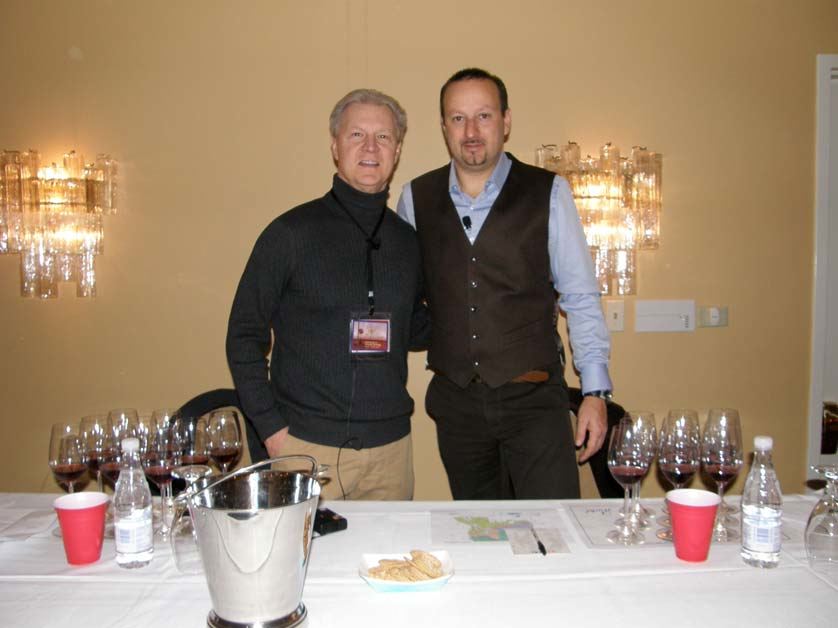
Domaine Fourrier has a four generation history in Gevrey-Chambertain and was one of the first domaines in
Burgundy to export wine to the United States. Domaine Fourrier has extensive holdings throughout most of the
heralded appellations of Burgundy, but the core vineyards are in Gevrey-Chambertin. The Domaine
experienced a revitalization by the arrival of Jean Marie Fourrier in 1994, who combined the traditions of his
father and uncle, his experience gained while working with Henri Jayer and Domaine Drouhin Oregon, and his
own clear sense of style. Jean Marie inaugurated his own winemaking technique at Domaine Fourrier in 1996,
by 1997 he was no longer racking the wines and leaving them in barrel for 18 months. By 1998 he had begun
his current technique of de-stemming and natural yeast fermentations. Since Jean Marie assumed the reigns at
Domaine Fourrier, the wines have garnered worldwide critical acclaim. Jean Marie puts his ego aside and
allows the terroir to speak. His wines are “terroir in a glass.”
The wines of Domaine Fourrier are only made from vines at least 30 years old. Selection massale is the single
method used to replace failing vines. No chemical fertilizers are used. Every vineyard is vinified separately.
Aging is carried out in no more than 20% new oak with the wines left on their lees until bottling which usually
occurs 20 to 24 months after harvest. Jean Marie avoids fining and filtering the wines if possible.
During the seminar, Allen made several salient comments about the three vintages tasted including 2005, 2006
and 2007. The wines exemplified his summary. The 2005 red Burgundies have power but not currently
open for business. They are 20 year wines. Prices are very high. The 2006 red Burgundies have good density
and extraction and are 30 year wines. They are more approachable now than the 2005 wines. The 2007 red
Burgundies are pure and elegant and the most drinkable now. These are 15 to 17 year wines.
2007 Domaine Fourrier Les Champeaux 1er Cru Gevrey-Chambertin
Very charming. The nose starts off
fruity, later becoming more nuanced with notes of chocolate, toast and oak. Pleasing elegance with balanced
tannins. Very tasty with unbelievable persistence. At a little less than $100 a bottle, this is a great Burg to buy
and enjoy now.
2005 Domaine Fourrier Les Goulots 1er Cru Gevrey-Chambertin
This wine has the biggest and most
striking nose of any wine in the tasting. Extraordinarily intense ripe dark fruits accented by white pepper and
minerals. Less tannin than the 2006 vintage and although showing glimpses of charm, it is currently monolithic
and impossible. This will be a prodigious wine in ten to fifteen years.
Unfortunately, finding the Burgundy you want is always a challenge. I would highly recommend you seek out
the 2007 Domaine Fourrier wines if you are looking for immediate gratification. If you are willing to wait, look
for the 2006 and 2005 vintage wines. Check www.wine-searcher.com, and www.vinquire.com for sources.
My overall impression this year of the many wines I tasted is that many of them taste the same and lack
distinctive characteristics. The overall quality of Pinot Noir from North America continues to shine, but there
are many wines that are just ordinary. The bar has been set higher, and producers must challenge themselves
to reach for more with Pinot Noir. The wines below are listed in the order they were tasted in the Press Room
at WOPN. I have starred the best wines for your quick perusal.
2006 Dukes Family Vineyards Alyssa Willamette Valley Pinot Noir
14.3% alc.. Produced and bottled by
Gypsy Dancer Estates.
·
Initially there is a fecal smell that blows off revealing subtle aromas of berries and
herbs. Moderately rich core of cherry and berry fruit with a tart citric edge to the nappy finish. Decent.
2007 TAZ Cuyama River Santa Maria Valley Pinot Noir
14.5% alc..
·
Moderate garnet color in the glass. Very appealing perfume of black cherries,
spice and mocha. Soft and velvety on the palate with tasty ripe Pinot fruits set
off by brown spices. A bit earthy and briny. Very good.
2007 TAZ Fiddlestix Vineyard Sta. Rita Hills Pinot Noir
14.8% alc..
·
Moderately colored with redder tones.
Shy nose that picks up interest with time in the glass revealing scents of dark red fruits and toasty oak. Lovely
core of smoky dark red cherry and berry fruits with an underlying earthiness. Fairly bold and tannic with more
oak than I prefer. Good.
2007 Three Sticks Durell Vineyard Sonoma Coast Pinot Noir
14.7% alc..
·
Moderate reddish-purple
color in the glass. Lovely aromas of macerated berries. Darker fruited with an underlying note of underbrush.
Very smoothly texture with well proportioned richness. Coats the mouth and leaves a lasting impression.
Very good.
2007 Stephen Ross Stone Corral Vineyard Edna Valley Pinot Noir
15.2% alc..
·
Dark in every way from the
color to the nose (dark fruits, dark chocolate), to the flavors (black fruits). A big-boned brooding wine with a
healthy tannic backbone and some persistence on the fruity finish. The alcohol is daunting, but is wellintegrated.
Good.
2007 Lucienne Doctor’s Vineyard Santa Lucia Highlands Pinot Noir
14.8% alc..
·
Moderately deep
reddish-purple robe in the glass. Very attractive nose replete with spiced berries. An extremely charming wine
with the berry fruit core enhanced with notes of spice, cola and chocolate. Discretely rich, beautifully balanced,
with an appealing elegance. Very good.
2007 Chamisal Vineyards Calita Selection
15.1% alc..
·
Very dark, deep color in the glass. A fruit-driven
wine with some sweetness and body propelled by the high alcohol. Purple fruited and moderately tannic.
Decent.
2007 Cadre The Architects California Pinot Noir
14.1% alc.. Sourced from four appellations: Laetitia
(Arroyo Grande), La Encantada Vineyard (Sta. Rita Hills), Firepeak Vineyard (Edna Valley), and Bien Nacido
Vineyard (Santa Maria Valley). This wine has received some very favorable reviews in the wine press but it was
to big and ripe for my taste.
·
Ripe black fruits with a hint of oak and cut flowers on the nose lead to a thick and
inky wine on the palate featuring chunky black fruits that are a touch roasted. A good tannic backbone
supports the prodigious fruit. Decent.
2007 Bjornstad Hellenthal Vineyard Sonoma Coast Pinot Noir
14.4% alc..
·
A bit exotic with aromas of
ripe plum, wild berries and toasty oak. Richly fruited and flavorful with husky tannins but with a marvelous
velvety texture and a refreshing spark of acidity on the lingering finish. Very good.
2008 Asuncion Ridge Vineyards San Luis Obispo County Pinot Noir
14.4% alc..
·
Very pretty aromatics
featuring black cherry and mixed berry fruit with roseate notes. Discretely concentrated core of black raspberry
fruit set off by accents of cola and coffee bean. Beautifully composed with supple tannins and respectable
persistence on the aromatic finish. I like this. Very good.
2004 Talisman Red Dog Vineyard Sonoma Mountain Pinot Noir
14.1% alc.. Talisman always pours
wines which are a vintage or two behind others.
·
Deep, dark reddish-purple color in the glass. Aromas of
sweet, ripe plums and sugared berries. A masculine, muscular wine featuring ripe dark fruits, moderate tannins
and an earth-toned fruity finish. This wine has many years ahead of it. Very good.
2007 Perception Russian River Valley Pinot Noir
13.8% alc..
·
Ripe dark berries are the featured fruit in this
wine veering toward raisiny flavors. Hard to recognize as Russian River Valley. Moderately grainy, dry tannins.
May have been watered back to reach the low alcohol. Decent.
2007 Roar Garys’ Vineyard Santa Lucia Highlands Pinot Noir
13.8% alc..
·
A very impressive wine that
breaks the mold of high extraction typical of the Roar style. Nicely perfumed with black cherries and blackberry
fruit. Very sensual and understated on the palate with appealing flavors of spiced berries set off by gossamer
tannins and proportioned acidity. One of the best wines tasted at WOPN. Very good.
2007 Lucia Garys’ Vineyard Santa Lucia Highlands Pinot Noir
14.5% alc..
·
The aromas are primarily oakderived
showing roasted coffee and dark chocolate. Darkly fruity and chunky, a bit rustic, with a prominent
chocolate flavor that should appeal to many. Has healthy tannins to stand up to hearty fare. Good.
2007 Hartford Court Arrendell Vineyard Russian River Valley Pinot Noir
14.3% alc..
·
Deep, dark reddishpurple
color in the glass. Love the nose and keep going back. Vivid and penetrating dark Pinot fruits with a
little oak riff. Luscious plum and deep berry fruit with a slight sweetness. Flavors of oak, tar and smoke add
interest. Smooth in the mouth with a slight watered-down tone on the finish which leaves a little heat in its
wake. Good.
2008 Freeman Russian River Valley Pinot Noir
14.2% alc..
·
Demure aromas of red cherries and berries.
Soft in the mouth with charming flavors of cherries and cherry cola. Oak is still prominent and may integrate
over time. Good.
2007 RN Estate Fiddlestix Vineyard Santa Rita Hills Pinot Noir
14.4%
alc., 120 cases.
·
A chameleon in the glass starting off with aromas of cherries,
summer herbs including sage, and oak ramping up in fruit intensity with notes of
good barnyard. Soft and delicate in the mouth but possessing a richly flavored
core of cherry and berry fruit. A tame style of Fiddlestix with very supple tannins.
This wine seduces more than it attacks. Very good.
2007 Byron Nielson Vineyard Santa Maria Valley Pinot Noir
14.6% alc.. The Nielson Vineyard was planted in 1964 by Uriel Nielson, the first commercial vineyard in
Santa Barbara County. The site is windy, arid and cold leading to low vigor vine
growth. Clones 113, 114, 115, 667, 777, 2A and Pommard.
·
Darkly colored.
Intensely fruity nose featuring dark berries with a hint of oak toast, oak spice
and sandalwood. Impressive explosion of fruit on the nose. Over time in the
glass, aromas of underbrush and brininess that is common in the Santa Maria
Valley Pinot Noir fruit emerges. Plenty of pleasing red and black fruits on the
palate with a sidecar of earth, tea and spice. A Caliesque-styled wine that
provides plenty of pleasure at a decent price. Perfect with a grilled steak. Very
good.
2007 Laetitia Reserve du Domaine Arroyo Grande Valley Pinot Noir
14.1% alc.. A barrel selection, estate grown, bottled and produced at Laetitia.
From a cool site 3 miles from the Pacific Ocean that is sustainably farmed.
Clones 115, 667, 459, 2A, Pommard 5, and Martini B. Aged 11 months in 40%
new and 60% neutral oak barrels. Eric Hickey is the winemaker.
·
Dark reddishpurple
color in the glass. Very appealing aromatics offering black cherries,
strawberries, spice, rose petals and a little ocean air. Luscious core of dark
berries and strawberries with hints of earthy loam and cola. Rich and full-bodied
but retains a charming appeal. Mild tannins make for easy drinking. A bold wine
that makes a statement and attracks your attention. Very good.
2007 Flowers Sonoma Coast Pinot Noir
13.4% alc..
·
Lightly colored with red tones. Scents of strawberries,
cherries, baking spices and a hint of oak char. On the lean side with redder fruits set off by an appealing
minerality and grassiness. The tannins are reigned in and the hi-strung finish features tart cherry and
cranberry flavors. Considering the vintage and the reputation of this superb winery, this wine is a bit
disappointing. Nevertheless it is Good.





